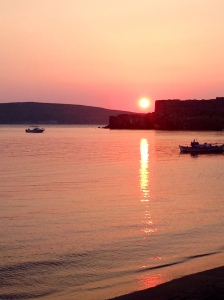For a second year we are spending August in Sigri, Lesvos. This
small and sleepy fishing village lies at the end of a long road that
snakes over the spine of the island away from the port and its ferries
and cars and lorries and cargo; tourists waiting for boats in
harbourside bars and restaurants. The trip takes you through hillsides
of olive trees, some areas scarred black from scrub fires, past salt pan
waters dotted with prawn-pink flamingoes. On past the town at the
crossroads that swelters in its basin and up into the central heights
where the air is cooler and rugged stone monasteries look down like
monks in prayer from skeletal, vertiginous outcrops. The road continues
its switchback course, down over the ridge, passing a scattering of
white houses and terracotta tiled roofs. The land grows in breadth as it
opens up beyond the pass and the light reflects back from umber rocks
and the harsh ochre of dried grass and bush, inducing a mild case of
photo-sensitivity, even behind a pair of sunglasses. A new road is being
hewn into the side of the hill and the shapes of ancient, petrified
trees rise out of the dust and rubble, protected for now by a
utilitarian coating of plaster – the bones of ancient monsters exposed
by modern machinery.
The road descends further and round a corner, finally, the bay sweeps into view; its glittering water, inlets and coves all watched over by the lazy, feline mound of the isle of Nissiopi opposite . At the southern edge of the coast, on a jutting peninsula, a cluster of buildings fall down the final slope to the small fishing harbour. The ruins of an old Ottoman fort are sketched in carbon against a vesperal sky. A restaurant on the sea-front is festooned with garlands of octopus tentacles which sway in the wind above the heads of the nut-brown, sea-weathered men who sit with a glass of ouzo in one hand and a clicking loop of kombolói – worry beads – in the other. The Meltemi is late this year, but here, at the edge of the village, standing in front of a handful of tiny carmine, white and indigo boats moored in the harbour, a breeze is kicking up heads of sea foam out towards the horizon.
It all feels a wonderfully long way from home.
The road descends further and round a corner, finally, the bay sweeps into view; its glittering water, inlets and coves all watched over by the lazy, feline mound of the isle of Nissiopi opposite . At the southern edge of the coast, on a jutting peninsula, a cluster of buildings fall down the final slope to the small fishing harbour. The ruins of an old Ottoman fort are sketched in carbon against a vesperal sky. A restaurant on the sea-front is festooned with garlands of octopus tentacles which sway in the wind above the heads of the nut-brown, sea-weathered men who sit with a glass of ouzo in one hand and a clicking loop of kombolói – worry beads – in the other. The Meltemi is late this year, but here, at the edge of the village, standing in front of a handful of tiny carmine, white and indigo boats moored in the harbour, a breeze is kicking up heads of sea foam out towards the horizon.
It all feels a wonderfully long way from home.



